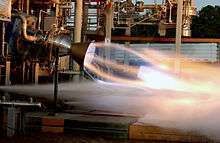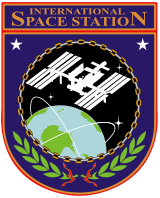Boeing CST-100 Starliner
.jpg) Rendering of the Boeing CST-100 Starliner | |
| Manufacturer | Boeing |
|---|---|
| Country of origin | United States |
| Operator | Boeing |
| Applications | Crew Transfer Vehicle |
| Specifications | |
| Spacecraft type | Crewed capsule |
| Design life | |
| Launch mass | 13,000 kg (29,000 lb) |
| Crew capacity | 7 |
| Dimensions | |
| Volume | 11 m3 (390 cu ft)[4] |
| Regime | Low Earth |
| Production | |
| Status | In development |
| First launch |
March 2019 (uncrewed, planned) August 2019 (crewed, planned)[5] |
The Boeing CST-100 Starliner (Crew Space Transportation) crew capsule is a spacecraft design under construction by Boeing as their entry for NASA's Commercial Crew Development (CCDev) program. Its primary purpose is to transport crew to the International Space Station (ISS)[6] and to private space stations such as the proposed Bigelow Aerospace Commercial Space Station.[7]
Starliner is similar in concept to the Orion spacecraft being built for NASA by Lockheed Martin.[8] The capsule has a diameter of 4.56 meters (15.0 ft),[3] which is slightly larger than the Apollo command module and smaller than the Orion capsule.[9] The Starliner is to support larger crews of up to seven people and is being designed to be able to remain on-orbit for up to seven months with reusability of up to ten missions.[10] As of 2010, it was intended to be compatible with four launch vehicles: Atlas V, Delta IV, Falcon 9, and Vulcan.[11] As of 2011, the initial launch vehicle was planned to be the Atlas V N22,[12] to be launched from SLC-41 at Cape Canaveral Air Force Station, Florida.
In the first phase of its CCDev program NASA awarded Boeing US$18 million in 2010 for preliminary development of the spacecraft.[13] In the second phase Boeing was awarded a $93 million contract in 2011 for further spacecraft development.[14] On August 3, 2012, NASA announced the award of $460 million to Boeing to continue work on the CST-100 under the Commercial Crew Integrated Capability (CCiCap) Program.[15] On September 16, 2014, NASA selected the CST-100, along with SpaceX's Dragon V2, for the Commercial Crew Transportation Capability (CCtCap) program, with an award of $4.2 billion.[16] As of October 2018, the spacecraft is expected to conduct an automated test mission to the ISS in March 2019, and to carry its first crew on a demonstration flight in August 2019.[5]
History
Background
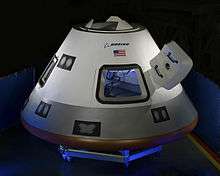
The design draws upon Boeing's experience with NASA's Apollo, Space Shuttle and ISS programs as well as the Orbital Express project sponsored by the Department of Defense.[9] The CST-100 has no Orion heritage, but it is sometimes confused with the earlier and similar Orion-derived Orion Lite proposal that Bigelow was reportedly working on with technical assistance from Lockheed Martin.[17] It will use the NASA Docking System for docking[18][19][20] and use the Boeing Lightweight Ablator for its heatshield.[21] The Starliner's solar cells will provide more than 2,900 watts of electricity, will be placed on top of the micro-meteoroid debris shield located at the bottom of the spacecraft's service module.[22]
As of 2010, it was intended to be compatible with multiple launch vehicles, including the Atlas V, Delta IV, and Falcon 9, as well as the planned Vulcan.[11]
Unlike earlier U.S. space capsules, the CST-100 will make airbag-cushioned landings on the ground rather than into water. Five landing areas are planned in the Western United States, which will give the CST-100 about 450 landing opportunities every year.[23]
As of 2014, the CST-100 was to include one space tourist seat, and the Boeing contract with NASA allows Boeing to price and sell passage to low-Earth orbit on that seat.[24]
Development
The CST-100 name was first used when the capsule was revealed to the public by Bigelow Aerospace CEO Robert Bigelow in June 2010.[25] The letters CST stand for Crew Space Transportation.[26] Although it has been reported that the number 100 in the name stands for 100 km, the height of the Kármán line which is one of several definitions of the boundary of space,[27][28] the naming was in fact an arbitrary designation created by the corporate office. The Rocketdyne RS-88 (Bantam) engine will be used for its launch escape system.[29]
Receiving the full fixed-price payments for the CCDev Phase 1 Space Act Agreement required a set of specific milestones to be met during 2010:[30]
- Trade study and down-select between pusher-type and tractor-style launch escape system
- System definition review
- Abort System Hardware Demonstration Test
- Base Heat Shield Fabrication Demonstration
- Avionics Systems Integration Facility demonstration
- CM Pressure Shell Fabrication Demonstration
- Landing System Demonstration (drop test and water uprighting test)
- Life Support Air Revitalization demonstration
- Autonomous Rendezvous and Docking (AR&D) hardware/software demonstration
- Crew Module Mockup demonstration
As of July 2010, Boeing stated that the capsule could be operational in 2015 with sufficient near-term approvals and funding, but also indicated they would proceed with development of the CST-100 only if NASA implemented the commercial crew transport initiative that was announced by the Obama administration in its FY11 budget request. Boeing executive Roger Krone stated that NASA investment would allow Boeing to close the business case, while this would be very difficult without NASA. In addition a second destination besides the ISS would be needed to close the business case and Krone said that cooperation with Bigelow was crucial for this.[9]
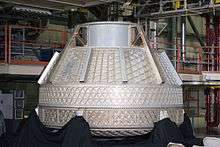
Boeing was awarded a $92.3 million contract by NASA in April 2011 to continue to develop the CST-100 under CCDev phase 2.[31] On August 3, 2012, NASA announced the award of $460 million to Boeing to continue work on the CST-100 under the Commercial Crew Integrated Capability (CCiCap) Program.[15]
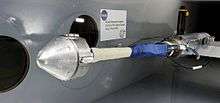
On October 31, 2011, NASA announced that through a partnership with Space Florida, the Orbiter Processing Facility-3 at Kennedy Space Center would be leased to Boeing for manufacture and test of CST-100 spacecraft.[32]
On September 16, 2014, NASA chose Boeing (CST-100) and SpaceX (Dragon V2) as the two companies that will be funded to develop systems to transport U.S. government crews to and from the International Space Station. Boeing won a $4.2 billion contract to complete and certify CST-100 spacecraft by 2017, while SpaceX won a $2.6 billion contract to complete and certify their crewed Dragon spacecraft. The contracts include at least one crewed flight test with at least one NASA astronaut aboard. Once the Starliner achieves NASA certification, the contract requires Boeing to conduct at least two, and as many as six, crewed missions to the space station.[33] NASA's William H. Gerstenmaier considers the CST-100 proposal as stronger than the two others.[34]
Part of the agreement with NASA allows Boeing to sell seats for space tourists. Boeing proposed including one seat per flight for a space flight participant at a price that would be competitive with what Roscosmos charges tourists.[35]
On September 4, 2015, Boeing announced that the CST-100 would officially be called the CST-100 Starliner, a name that follows the conventions of the 787 Dreamliner produced by Boeing Commercial Airplanes.[36] In November 2015, NASA announced it had dropped Boeing from consideration in the multibillion-dollar Commercial Resupply Services second-phase competition to fly cargo to the International Space Station.[37]
In May 2016, Boeing delayed its first scheduled CST-100 launch from 2017 to early 2018.[38][39] Then in October 2016, Boeing delayed its program by six months, from early 2018 to late 2018, following supplier holdups and a production problem on the second CST-100. By 2016, they were hoping to fly NASA astronauts to the ISS by December 2018.[38][40]
In April 2018, NASA suggested the first planned two-person flight of the CST-100 Starliner, slated for November 2018, was now likely to occur in 2019 or 2020. If the delays are maintained it would be expected to carry one additional crew member and extra supplies. Instead of staying for two weeks as originally planned, NASA said the expanded crew could stay at the station for as long as six months as a normal rotational flight.[41]
Testing
A variety of validation tests have been underway on test articles since 2011.
In September 2011, Boeing announced the completion of a set of ground drop tests to validate the design of the airbag cushioning system. The airbags are located underneath the heat shield of the CST-100, which is designed to be separated from the capsule while under parachute descent at about 5,000 feet (1,500 m) altitude. The airbags are deployed by filling with a mixture of compressed nitrogen and oxygen gas, not with the pyro-explosive mixture sometimes used in automotive airbags. The tests were carried out in the Mojave Desert of southeast California, at ground speeds between 10 and 30 miles per hour (16 and 48 km/h) in order to simulate crosswind conditions at the time of landing. Bigelow Aerospace built the mobile test rig and conducted the tests.[26]
In April 2012, Boeing dropped a mock-up of its CST-100 commercial crew capsule over the Nevada desert at the Delamar Dry Lake near Alamo, Nevada, successfully testing the craft's three main landing parachutes from 11,000 feet (3,400 m).[42]
In August 2013, Boeing announced that two NASA astronauts evaluated communications, ergonomics, and crew-interface aspects of the CST-100, showing how future astronauts will operate in the spacecraft as it transports them to the International Space Station and other low Earth orbit destinations.[43]
Boeing reported in May 2016 that its test schedule would slip by eight months in order to reduce the mass of the spacecraft and aerodynamics issues anticipated during launch and ascent on the Atlas V rocket.[44] The booster for the Orbital Flight Test, an Atlas V N22 rocket, is being assembled at ULA's facility at Decatur, Alabama, as of January 2018.[45] The first crewed flight (Boe-CFT) is scheduled for early 2019, depending on test results from Boe-OFT. It is planned to last 14 days and carry one NASA astronaut and one Boeing test pilot to the ISS.[46] On April 5, 2018, NASA announced that the first planned two-person flight, originally slated for November 2018, is now likely to occur in 2019 or 2020. If this delay occurs the mission could be expected to carry one additional crew member and supplies. NASA said the expanded crew could stay at the station for as long as six months as a normal rotational flight. This is due to the ending of the agreement for Russia to ferry astronauts to and from the International Space Station in late 2019.[47] NASA has named its first Commercial Crew astronaut cadre of four veteran astronauts to work with SpaceX and Boeing: Robert Behnken, Eric Boe, Sunita Williams, and Douglas Hurley.[48] In July 2018 Boeing announced the assignment of former NASA astronaut Chris Ferguson to the Boe-CFT mission.
In July 2018, a test anomaly was reported in which there was a hypergolic propellant leak due to several faulty abort system valves. Consequentially the first unpiloted orbital mission was delayed to March 2019, and the first crew launch rescheduled to August 2019.[5]
Crew
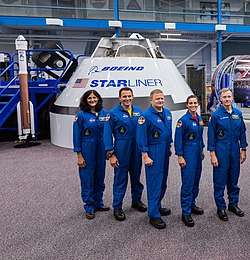
On August 3, 2018, NASA announced the following astronauts will participate in the first Starliner flights:[49][50]
- First test crew - Boe-CFT: Eric Boe, Christopher Ferguson, Nicole Aunapu Mann
- First mission crew - CTS-1: Josh Cassada, Sunita Williams
Technology partners
- Aerojet Rocketdyne
- Airborne Systems
- Alliant Techsystems
- Bigelow Aerospace
- Samsung
- Spincraft
See also
- Crew Exploration Vehicle
- Dragon 2
- Dream Chaser, a human-rated spaceplane under development
- Federation, a human-rated spacecraft being developed in Russia
- New Shepard
- Private spaceflight
References
- 1 2 Reiley, Keith; Burghardt, Michael; Wood, Michael; Ingham, Jay; Lembeck, Michael (2011). Design Considerations for a Commercial Crew Transportation System (PDF). AIAA SPACE 2011 Conference & Exposition. September 27–29, 2011. Long Beach, California. doi:10.2514/6.2011-7101.
- ↑ Carreau, Mark (July 24, 2013). "Boeing Refines CST-100 Commercial Crew Capsule Approach". Aviation Week. Retrieved May 8, 2014.
- 1 2 3 Burghardt, Mike (August 2011). "Boeing CST-100: Commercial Crew Transportation System" (PDF). Boeing. Retrieved May 8, 2014.
- ↑ Krebs, Gunther (April 2017). "Starliner (CST-100)". Gunthers Space Page. Retrieved April 11, 2017.
- 1 2 3 "NASA's Commercial Crew Program Target Test Flight Dates". October 4, 2018. Retrieved October 5, 2018.
- ↑ Memi, Edmund G.; Morgan, Adam K. (September 23, 2009). "Boeing Submits Proposal for NASA Commercial Crew Transport System" (Press release). Boeing.
- ↑ "Orbital Complex Construction". Bigelow Aerospace. Archived from the original on July 10, 2010. Retrieved July 15, 2010.
- ↑ Chow, Denise (June 25, 2010). "New Boeing Spaceship Targets Commercial Missions". Space.com.
- 1 2 3 Clark, Stephen (July 21, 2010). "Boeing space capsule could be operational by 2015". Spaceflight Now. Retrieved September 18, 2011.
- ↑ "Boeing: Crew Space Transportation (CST) System". Boeing. Retrieved January 25, 2016.
- 1 2 Lindenmoyer, Alan (2010). Commercial Crew and Cargo Program (PDF). 13th Annual FAA Commercial Space Transportation Conference. February 10–11, 2010. Arlington, Virginia. Archived from the original (PDF) on March 5, 2010.
- ↑ Memi, Edmund G.; Rye, Jessica F. (August 4, 2011). "Boeing Selects Atlas V Rocket for Initial Commercial Crew Launches" (Press release). Boeing. Retrieved October 29, 2011.
- ↑ Memi, Edmund G.; Gold, Michael N. (February 2, 2010). "NASA Selects Boeing for American Recovery and Reinvestment Act Award to Study Crew Capsule-based Design" (Press release). Boeing.
- ↑ Morring, Jr., Frank (April 25, 2011). "Five Vehicles Vie For Future Of U.S. Human Spaceflight". Aviation Week. Archived from the original on May 9, 2014.
the CCDev-2 awards, ... went to Blue Origin, Boeing, Sierra Nevada Corp. and Space Exploration Technologies Inc. (SpaceX).
- 1 2 "Boeing, SpaceX and Sierra Nevada Win CCiCAP Awards". SpaceNews. August 3, 2012. Archived from the original on January 4, 2013.
- ↑ "Boeing and SpaceX Selected to Build America's New Crew Space Transportation System". NASA. September 16, 2014. Retrieved April 6, 2015.
- ↑ Klamper, Amy (August 14, 2009). "Company pitches 'lite' spaceship to NASA". NBC News. Retrieved September 7, 2009.
- ↑ Grondin, Yves-A. (August 5, 2013). "NASA Outlines its Plans for Commercial Crew Certification". NASA Spaceflight.
- ↑ Commercial Space Flight Panel. YouTube.com. SpaceUp Houston. 2011.
- ↑ Messier, Doug (March 23, 2011). "Update on Boeing CST-100 Crew Program". Parabolic Arc.
- ↑ Latrell, Joe (July 28, 2015). "Boeing's CST-100 takes shape at former NASA facility". Spaceflight Insider. Retrieved August 3, 2018.
- ↑ http://www.compoundsemi.com/spectrolab-solar-cells-power-boeings-starliner-spacecraft/
- ↑ Clark, Stephen (22 September 2015). "Boeing identifies CST-100 prime landing sites". Spaceflight Now. Retrieved 5 August 2018.
- ↑ "Boeing space taxi has tourist seat". Canadian Broadcasting Company. Thomson Reuters. September 18, 2014. Retrieved January 7, 2017.
- ↑ Gedmark, John; Gold, Mike (June 16, 2010). "Bigelow Aerospace Joins the Commercial Spaceflight Federation" (Press release). Commercial Spaceflight Federation.
- 1 2 Memi, Edmund G. (September 12, 2011). "Space capsule tests aim to ensure safe landings". Boeing. Archived from the original on September 24, 2011. Retrieved September 18, 2011.
- ↑ Memi, Edmund G.; Morgan, Adam K. (July 19, 2010). "Boeing CST-100 Spacecraft to Provide Commercial Crew Transportation Services" (Press release). Boeing.
- ↑ Chow, Denise (July 19, 2010). "New Spaceship Could Fly People to Private Space Stations". Space.com.
- ↑ Test of Rocketdyne abort motor for Boeing crew capsule. YouTube.com. Retrieved November 24, 2011.
- ↑ "Space Act Agreement Between National Aeronautics and Space Administration and The Boeing Company for Commercial Crew Development (CCDev)" (PDF). NASA. February 2010.
- ↑ Dean, James (April 18, 2011). "NASA awards $270 million for commercial crew efforts". Florida Today. The Flame Trench. Archived from the original on April 19, 2011.
- ↑ Weaver, David; Curie, Michael; Philman, Amber; Lange, Tina; Korn, Paula (October 31, 2011). "NASA Signs Agreement with Space Florida to Reuse Kennedy Facilities" (Press release). NASA.
- ↑ Schierholz, Stephanie; Martin, Stephanie (September 16, 2014). "NASA Chooses American Companies to Transport U.S. Astronauts to International Space Station". NASA. Retrieved September 18, 2014.
- ↑ Norris, Guy (October 11, 2014). "Why NASA Rejected Sierra Nevada's Commercial Crew Vehicle". Aviation Week. Archived from the original on October 13, 2014. Retrieved October 13, 2014.
- ↑ Klotz, Irene (September 17, 2014). "Boeing's 'space taxi' includes seat for a tourist". Reuters. Retrieved August 6, 2015.
- ↑ Clark, Stephen (September 4, 2015). "Enter the Starliner: Boeing names its commercial spaceship". Spaceflight Now. Retrieved September 4, 2015.
- ↑ Rhian, Jason (November 6, 2015). "NASA delays CRS 2 awards again, drops Boeing from consideration". Spaceflight Insider. Retrieved November 21, 2015.
- 1 2 Berger, Eric (October 11, 2016). "Boeing delays Starliner again, casting doubt on commercial flights in 2018". Ars Technica. Retrieved April 6, 2018.
- ↑ Berger, Eric (May 11, 2016). "Boeing's first crewed Starliner launch slips to 2018". Ars Technica. Retrieved April 6, 2018.
- ↑ Norris, Guy (October 10, 2016). "Boeing Delays CST-100, Still Targets 2018 ISS Mission". Aviation Week & Space Technology. Retrieved October 11, 2016.
- ↑ Pasztor, Andy (April 5, 2018). "NASA, Boeing Signal Regular Missions to Space Station to Be Delayed". The Wall Street Journal. Retrieved April 6, 2018.
- ↑ Clark, Stephen (April 3, 2012). "Parachutes for Boeing crew capsule tested over Nevada". Spaceflight Now. Retrieved April 3, 2012.
- ↑ "Boeing Space Capsule One Step Closer to Orbit". NYSE Big Stage. August 19, 2013. Archived from the original on October 4, 2013.
- ↑ Foust, Jeff (May 12, 2016). "Boeing delays first crewed CST-100 flight to 2018". SpaceNews.
- ↑ Rhian, Jason (January 4, 2018). "Boeing CST-100 Starliner one step closer to flight with completion of DCR". Spaceflight Insider. Retrieved April 8, 2018.
- ↑ Bergin, Chris (November 27, 2017). "Boeing Starliner trio preparing for test flights". NASASpaceFlight.com. Retrieved April 8, 2018.
- ↑ Pasztor, Andy (April 5, 2018). "NASA, Boeing Signal Regular Missions to Space Station to Be Delayed". The Wall Street Journal. Retrieved April 8, 2018.
- ↑ Pearlman, Robert Z. (July 9, 2015). "NASA assigns 4 astronauts to commercial Boeing, SpaceX test flights". CollectSpace. Retrieved December 31, 2016.
- ↑ Chavers, Alex (January 9, 2017). "NASA Picks SpaceX and Boeing's First Crew". News Ledge. Retrieved August 3, 2018.
- ↑ "NASA Assigns Crews to First Test Flights, Missions on Commercial Spacecraft". NASA. August 3, 2018. Retrieved August 3, 2018.
External links
| Wikimedia Commons has media related to CST-100 (spacecraft). |
- CST-100 Starliner at Boeing.com
- Boeing/Bigelow Crew Space Transport Vehicle on YouTube by Boeing (2010)
- Boeing Unveils America's First Space Taxi, Unlocks Possibilities for Future on YouTube by Boeing (2014)

